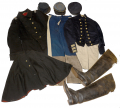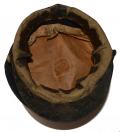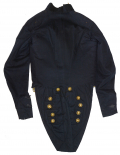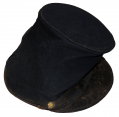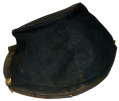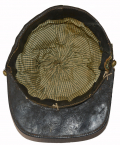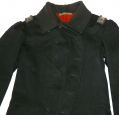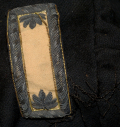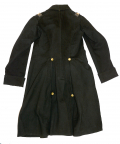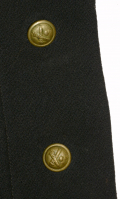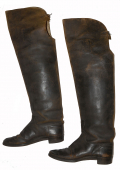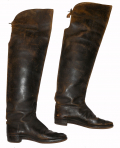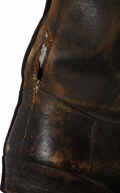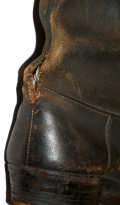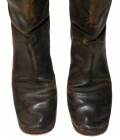site search
online catalog
CONFEDERATE OFFICER’S UNIFORM GROUP OF LIEUTENANT, CAPTAIN AND MAJOR HUGH MORTIMER NELSON: 1st VA CAVALRY, 6th VA CAVALRY, ADC TO EWELL, WIA GAINES MILL
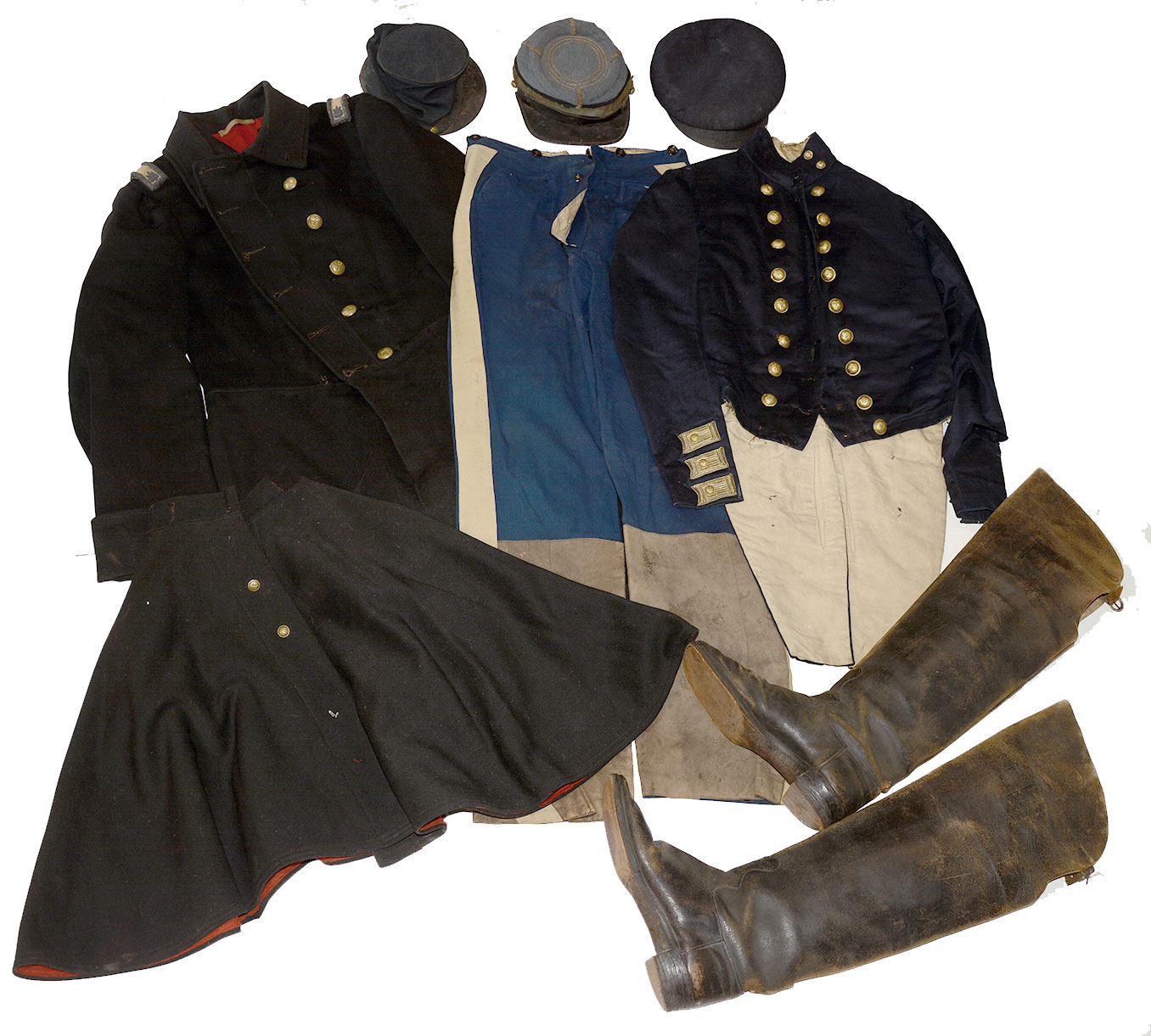
$95,000.00
Quantity Available: 1
Item Code: 153-09
Shipping: Determined by Method & Location of buyer
To Order:
Call 717-334-0347,
Fax 717-334-5016, or E-mail
This wonderful Confederate officer’s grouping came directly out of the family, from the officer’s great-great-grandson in 1995, and went into the collection of esteemed artist, collector and historian Don Troiani, who pictured parts of it in his Soldiers in America and Uniforms and Regiments of the Civil War. The group includes Nelson’s prewar Viriginia militia cavalry Captain’s coat, trousers, and privately purchased M1839 forage cap, which he likely donned again in his whirlwind two-day recruiting drive to raise a new cavalry company in June 1861. We note this cap mirrors that worn by Stonewall Jackson at Bull Run: “His cap was of the old army pattern, in vogue during the Mexican War, - blue cloth, flat on top,” (a member of the Washington Artillery who saw Jackson on the field.) A second cap in the group is also Jackson in style- Nelson’s early-war, dark blue 1858 pattern forage cap, with tall crown and downturned crescent visor, so similar to Jackson’s now in the American Civil War Museum that they could have come from the same maker. The similarities may not be coincidental: not only did Nelson serve under Jackson, they likely knew one another in pre-war Virginia society. The group also includes a third cap- Nelson’s privately made, gray Confederate 1861 pattern chasseur style kepi, using Adophus’s terminology, using a very typical black band around the base in place of a more difficult to obtain branch of service color, altered for Nelson by the addition of gold braid to reflect his rank of Major of Cavalry, which he attained before his death in August 1862. Equally impressive is Nelson’s red-lined black officer’s overcoat with detachable red-lined cape, which Nelson fitted with cavalry major’s shoulder straps after his promotion. Together with these is a magnificent pair of very tall, over-the-knee boots perfect for a well-equipped mounted officer, in this case one who served not only in the 1st and 6th Virginia Cavalry in 1861-1862, but was on the staff of General R.S. Ewell in Jackson’s 1862 Valley Campaign and in the Seven Days Battles on the Peninsula in Summer 1862.
Born in Hanover County, VA, in 1811, Nelson was educated at home, a local classical school, an academy at Winchester, and the University of Virginia, from which he graduated in 1832 with a Master of Arts degree, one of the few awarded by the school up to that time. He taught school in Charles City County, VA, married in November 1836 and then moved to Baltimore, where he studied law and passed the bar, but was forced by “pecuniary considerations” to return to Virginia before he could effectively establish a practice. He was nevertheless able to purchase from a relative the Shenandoah Valley estate of Long Branch, now preserved house and farm open to the public in Clarke County, where he set himself up as a gentleman farmer in 1842.
In the later 1840s he went to Europe to consult doctors regarding an injury and was in Paris to witness the Revolution of February 1848. Given his family’s social standing, he was likely concerned about similar social and political unrest at home: on his return he re-raised the Clarke County Cavalry, a militia unit that had existed off and on since the War of 1812, and commanded it to about 1856. His political sentiments might perhaps be guessed from his return with and use of a saddle that had belonged to the deposed King Louis Phillipe.
When the cavalry company organized again in 1859, however, no doubt in response to John Brown’s raid, it was under another Captain, with Nelson apparently turning to politics, being chosen as a county delegate to the Virginia Convention, which met starting in February 1861 to debate secession. Although avowedly opposed to secession, he finally yielded after Lincoln’s call for troops and the firing on Fort Sumter in April, but did not join his old company when it helped seize the U.S. armory at Harpers Ferry and joined Virginia troops organizing there, instead continuing his legislative duties through the Convention’s June session. He was concerned, however, about the Shenandoah’s vulnerability to northern incursion and signed an appeal to Lee for cannon to arm regional artillery companies in late April, and after the June session of the Convention raced to recruit another company of cavalry. “He rode constantly, and by dint of extraordinary exertion- offering as an inducement to volunteer, to some a horse, to others a bounty…” and inside of two days managed to gather a company of 40 men whom he led to join Johnston’s forces, performing scouting and screening duties against Patterson’s Union forces until Johnston could slip away and join Beauregard at Manassas. At that point Nelson and his improvised troop disbanded, only for Nelson to be informed shortly after that on the eve of First Manassas the Captain of the Clarke County Cavalry had resigned and the men had elected him to fill the vacancy, with company then serving as Co. D, 1st Virginia Cavalry.
He was officially enlisted by Jeb Stuart to serve as Captain for one year as of July 21, 1861, though not reaching the field until after the battle. We might well expect he had not had time yet to update his old uniform and his acquisition of an 1858 pattern forage cap likely dates sometime soon after, with the dark blue color conforming to prewar Virginia specifications and evident in Virginia forces well into Fall 1861 according to Todd. The black overcoat and cape in the group date to that period: a receipt to him from Richmond military clothier W.I. Smith (sold at auction in 2009) lists an overcoat, jacket and pants is dated Dec. 3, 1861. In any event, the company was one of two transferred from the regiment to the 6th Virginia Cavalry to equalize numbers in September 1861 and we find Nelson present with them until April 20, 1862, with exception of a brief absence in November to attend the last session of the State Convention. The company is credited mainly with outpost duty during the winter, though we note the regiment was also credited with a skirmish at Burke’s Station in December.
Nelson served with the regiment until April 20, 1862, when he was one of twenty officers in the regiment not re-elected by their companies during the Spring re-organization of the army, something attributed by many involved to the unpopularity of officers who were best at inculcating military discipline. Whatever the reasons, he immediately applied to General R.S. Ewell for a staff appointment as an Assistant Adjutant General, helpfully pointing out to Ewell he was legally allowed to have one. Ewell, who had been ordered to the Shenandoah to join Jackson responded on May 4, 1862, from Conrad’s Store (now Elkton,) offering him instead the position of Aide-de-Camp. Nelson accepted, stopped briefly at home on May 23, and on May 24 made his way to join Ewell at Winchester, narrowly avoiding capture by some Union cavalry in the process.
As a “Volunteer Aide-de-Camp” and we find Nelson still referred to as Captain into June, but when officially appointed ADC on July 2, 1862, he was ranked as just a 1st Lieutenant. Perhaps to make up for this he was promoted to “Major of Cavalry” at a date unstated, but likely in June or July as well, with the records lacking because he died before confirmation or muster. Nelson died of Typhoid on August 6, 1862, and Ewell’s August 7, 1862, letter of condolence, printed in the UVA memorial for Confederate alumni, refers to him as Major, as does G. Campbell Brown in his reminiscences of service on Ewell’s staff, so the Confederate officer’s cap and his addition of cavalry Major’s shoulder straps to his overcoat clearly date to this period.
Ewell noted his profound grief at Nelson’s death, despite their relatively short acquaintance, and had clearly been impressed by Nelson’s zeal and performance in the field, citing several instances of service under fire: “the affair of Strasburg in June, the battle of Cross Keys, Port Republic, and the terrible conflicts below Richmond.” This is supplemented by references in the Official Records where Confederate officers record him guiding their regiments into position, as well as his slight wounding (a contusion in Ewell’s words,) in the fighting at Gaines Mill on June 27. This did not remove him from the field and at least two officers noted his calm behavior among Ewell’s staff under Union artillery fire at Malvern Hill on July 1, the final battle of the Seven Days on the Peninsula.
Both Ewell and Campbell Brown clearly thought Nelson had sacrificed himself for the cause. Brown recorded everyone’s surprise at Nelson’s death, which occurred at a relative’s house in Albemarle County, after being forced to fall out near Gordonsville on the march to confront Pope, attributing it to his, “too great exposure & exertions below Richmond,” and noting the staff “had known nothing of his being so ill.” Ewell, too, attributed his death ultimately to his “too great anxiety to take the field.” Campbell Brown and two other fellow staff members attended the funeral, which was, “simple, but impressive, and the attendance was quite large.”
Nelson’s uniform group includes the following items:
1) Nelson’s 1839 pattern forage cap. This is a commercial version of the U.S. Army regulation, dark blue, “wheel” style forage cap of the period, bearing an indecipherable maker’s mark on the underside of the crown. We illustrate a daguerreotype formerly in Herb Peck’s collection showing a U.S. dragoon officer wearing this style of undress cap with his full-dress coatee in a rather flamboyant, cavalier manner. We also note the style could remain in use rather late. Troiani illustrates this very cap on page 3 of Uniforms and Regiments and follows it up on page 10 with his painting of Stonewall Jackson at First Manassas wearing the same headgear, something well-attested to. The flat round top is about 9” in diameter, rising about 3-1/4” from the lower edge of the cap, with 1” tall band around its base, with crescent sloping visor. Chinstrap is leather, ¾” wide, secured on either side by a US Navy button. The strap was broken at the wearer’s right ear and has had a strip of blue cloth glued in behind it on that side to reach the button and hold it in place. The sweatband is in place inside, about 1-1/2” tall, complete, made of cloth with an enameled finish that shows a lot of wear, but no holes or tears. The lining is a light brown thin leather that would help it keep its shape.
2) Nelson’s 1832 pattern dress coatee. This dates from his first command of the Clarke County Cavalry, dated by Brown’s Clarke County Annals as 1845-1856, but by the UVA Alumni Memorial (1871) to his return from his 1848 visit to France. The coat retains three gold bullion embroidered loops or false-buttonholes on each cuff, the regulation U.S. rank insignia for a Captain from 1833 through 1851. State regulations might vary and older organizations be exempted by states from their own uniform changes. Two rows of 9 buttons each on the chest; 4 on the back; 3 small on each cuff. Buttons are US three-piece rimmed US General Staff, “R & W Robinson / Makers / Attleborough, Mass backmarks (Tice GS214A1- Albert GS8.) Interior is lined and quilted in white. Heavier white material with pockets in the tails. Left sleeve has torn cuff and is missing the lining. Right sleeve show wear to the lining at the armpit. Wear to interior of lined collar and along lower edge of waist. Lapel button holes show wear from use. Collar trim is absent, but two small general staff buttons remain on wearer’s left collar. There are sewn grommet holes for attachment of epaulets on each shoulder.
3) Nelson’s cavalry officer’s trousers. Blue with yellow 1-3/4” wide stripe down the outer seam of each leg to the cuff. The narrow waistband is tightened by a strap and buckle on the back and has 6 black enameled suspender buttons in place, as well as one on the front center and five on the fly. Narrow waistband lining and short 3” lining below that along the back from pocket to pocket except for narrow inverted V at center rear. Two pockets on the front waist, with arched openings each closed by one button (in place on the left, missing on the right.) Small watch pocket on the right, with period brown ink identification, “H.M. Nelson” in script with flourish and “15,” perhaps the tailor’s identification. The lower 14” of either leg is covered in a thin goatskin or chamois type leather, gray-brown in color. Two buttons inside each cuff show they were to be worn over shoes or bootees and secured by an instep strap, serving as a more elegant version of “breed leggings” affected by some prewar U.S. dragoons on campaign in the west to protect the lower leg. The condition overall is excellent, showing strong medium blue color, the yellow faded slightly to a light mustard color, and having just a very, very few small moth nips and one short, repaired tear near the right pocket.
4) Nelson’s early war 1858 style forage cap. Dark blue wool, rather tall floppy style with sloping crescent visor. Virtually no moth damage to the exterior. Two-piece body, front seam 4” and back seam 6” with panels extending all the way from top edge to bottom, with no band around the bottom. Reeded top edge around the crown. Black leather down-turned crescent visor 2” deep at center with sewn border line about 1/8 from the edge. Reeded back edge at cap body. Visor is firmly attached and has good color. Minor surface crazing and a few small losses to the thin black finish, which blend in well. Chinstrap of thin, black leather, ½” wide. Two pieces, about 9” each, one ending in a point; the other squared. No loop or buckle present. Secured at the sides by matching small brass buttons, two-piece, relatively flat, 3/8” diameter, with geometric six-pointed star motifs with lined central ground. The interior is fully lined in brown polished cotton. Black impressed leather (goatskin?) sweatband 1-1/8” tall. The sweatband is complete, but partially detached. In place from about the wearer’s left eye around the back to the rear center. The lining is complete, with no large holes but some runs around the lower edge that would correspond with the top edge of the sweatband.
5) Nelson’s gray Confederate officer’s chasseur style kepi, with flat leather visor with bound edge, and inset top, with front rising 3” from the upper surface of the visor, and the rear seam 5” long. Circled around the bottom by black band 1-3/8” tall. Over this lower band has been sewn a gold bullion band 7/8” tall also circling the base of the cap. Strands of bullion braid 5/16” wide rise from the top of wide gold bad and go over the top roll of the cap, stopping at the inset crown. Three narrow braids of gold bullion cord about 1/16” wide are arranged in concentric circles on the top. The interior has a thin black sweatband 1-1/8” wide in place. The cap is lined with a blue and white lined fabric with drawstring top, showing a similar fabric on the underside of the top. The visor had clearly come loose at some point and is held in place at the sides and front by thread ties. The thin leather chin strap is 5/8” wide, two-piece, with loop and stamped brass friction buckle. The side buttons are small, gilt brass civilian buttons with geometric and floral designs, similar but not identical to some other buttons in the set. This fits the 1861 pattern cap described and illustrated by Adolphus in his great series of articles, titled The Quintessential Confederate Cap, particularly Part 1. This was a popular pattern, used throughout the war and substituted a simple black band around the base of the cap for the regulation branch of service color. Adolphus refers to a similar cap as bearing, “the universal black trim color and regulation cadet gray sides and crown,” and notes elsewhere, “the black band reflects the prolific use of this color for trimming Confederate uniforms. Even though black was not an official branch-of-service color, it served as a viable substitute for official colors since it was readily available throughout the South.” This is certainly a privately made piece and was modified for Nelson by the addition of gold bullion band around the base, over the black, and the addition of gold braid running up the front, back and sides of the cap, and forming three concentric circles on the crown, indicating a Major. This cap would then date to his placement of Major’s shoulder straps on the overcoat below. The cap is excellent, showing just a couple of light moth nips, some wear to the gold band around the base of the cap and the visor which is loose.
6) Nelson’s red-lined black overcoat bearing cavalry Major’s shoulder straps and with its matching detachable cape. This is an eye-catching uniform item and certainly the overcoat listed as purchased by Nelson from Richmond military clothing supplier W. I. Smith on Dec. 3, 1861, on a receipt to Nelson, sold at auction in 2009. The lower seam of the collar was fitted with 7 flat, black cloth covered metal buttons to secure the detachable cape. Two of these buttons remain. Two shoulder straps remain in place, 1-1/2” by 4” with the bullion borders and oak leaf rank insignia in place, oxidized to a muted silver gray. The single row bullion borders are alternating dead and bright bullion. The jaceron wire is present, though pulled slightly on the outer edge of the wearer’s right strap. The yellow ground has good muted color and no mothing. The coat itself is double breasted to fasten with two rows of seven large buttons each. The back has long pockets accessible from the outside, and has two large buttons at the rear waist and one at the bottom of each pocket opening. Only the seven buttons on the wearer’s left lapel and the four on the rear remain. These are all South Carolina militia buttons with Canfield Bro. & Co. / Baltimore backmarks (Tice SC244A- Albert SC 11.) It is unclear why Nelson would have used South Carolina buttons, but if purchased in December 1861 the local supply of Virginia buttons was perhaps wearing thin. In any case, they are all original to the coat. Only one button remains on the collar and that is a small US ordnance button, two more of which appear on the cape.
7) Cape. Standing collar 1-1/4” tall at back center. 7 buttonholes for attachment to the coat. Four of the button holes are torn at the top. Front lapel measures 17” and rear seam 18”. Cape with 7 button holes. Two buttons are in place, in the second and third positions. Both small size Scovills / Waterbury backmarked US Ordnance buttons with crossed cannon barrels showing US with flaming bomb at top on lined ground (15mm; Tice ORD200) Ca.1834-1851. The exterior is in excellent condition with no mothing. Interior is lined in red wool with scattered small moth bites, one larger 1”X1” at left center and a couple ½” holes, but solid and overall very good with good color. The hanging tab in place at back of collar.
8) Boots: A beautiful pair of tall boots with knee flaps. Nelson clearly obtained these from another officer. “Nelson” is written on the inside of the knee flaps with “Lt. Bradford” crossed out, but visible underneath. The toes are square. The soles are contoured left and right. Brown leather with a few rubs. 24-1/2” tall overall; back seam is 17-1/2” with the edge then curving forward about 2” on either side before turning vertical again to about 6” above the back, and then curving to protect the knee, another inch or so higher at the very front. Each boot has a short leather strap that would buckle around the back of the knee, about 4” above the top edge of the back, using a brass horseshoe buckled, with the front of the knee flap rising another 3” or so. Both boots have two pull tabs/loops about 6” long sewn inside the rising to the top edge of the boots. The leather is excellent, with nice brown finish. The only defects we see is a short opening on the back seam of each just at the ankle: on the right about 1” and on the left about 2” with a slight tear. The thin leather fastening straps behind the knee of each are broken. On the left about 2” remains; on the right about 1” but only partially attached. The brass horseshoe buckles, on the outer edge of each, are firmly in place.
This is a wonderful set, coming from an officer who his fellow officers thought had clearly sacrificed himself in his dedication to duty and the cause, and is accompanied by a letter of provenance from Nelson’s great-great-grandson, research files including genealogical and service information, and has a great pedigree to a prominent collection. [sr] [ph:L]
Additional shipping charge required.
~~~~~~~~~~~~~~~~~~~~~~~~~~~~~~~~~~~
THIS ITEM, AS WITH ALL OTHER ITEMS AVAILABLE ON OUR WEB SITE,
MAY BE PURCHASED THROUGH OUR LAYAWAY PROGRAM.
CLICK HERE FOR OUR POLICIES AND TERMS.
THANK YOU!
Inquire About CONFEDERATE OFFICER’S UNIFORM GROUP OF LIEUTENANT, CAPTAIN AND MAJOR HUGH MORTIMER NELSON: 1st VA CAVALRY, 6th VA CAVALRY, ADC TO EWELL, WIA GAINES MILL
For inquiries, please email us at [email protected]
Most Popular
Historical Firearms Stolen From The National Civil War Museum In Harrisburg, Pa »
Theft From Gravesite Of Gen. John Reynolds »
Selection Of Unframed Prints By Don Troiani »
Fine Condition Brass Infantry Bugle Insignia »
British Imported, Confederate Used Bayonet »
Scarce New Model 1865 Sharps Still In Percussion Near Factory New »
featured item
SCARCE VIEW OF CONFEDERATE GENERAL THOMAS ROSSER FROM THE ALBUM OF R. CHANNING PRICE PRESENTED TO HIM BY JEB STUART
CDV is a full standing view of Thomas L. Rosser wearing a dark civilian frock coat with a white vest and dark cravat with matching white trousers. He holds his dark hat in his hand, just behind his waist. Rosser is posed in front of a painted… (846-497). Learn More »
site search
Upcoming Events
May 16 - 18: N-SSA Spring Nationals, Fort Shenandoah, Winchester, VA Learn More »



